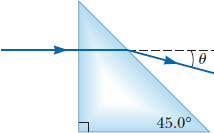A) The transmitted beam that exits the hypotenuse of the prism makes an angle of ? = 17.5° with the direction of the incident beam. What is the index of refraction of the prism? B) In part (a), we assumed the beam was monochromatic. Consider instead the case where the beam was composed of white light. Because the index of refraction differs for different wavelengths, the white light would be dispersed into constituent colors. Assume the index of refraction for blue wavelengths is 1.01n and for red wavelengths it is 0.99n, where n is the index of refraction found in part (a). What is the angular spread (in degrees) between red and blue light exiting the prism?
Refraction of Light
Refraction is a change in the direction of light rays when they travel from one medium to another. It is the bending of light when it goes through different media.
Angle of Refraction
Light is considered by many scientists to have dual nature, both particle nature and wave nature. First, Particle nature is one in which we consider a stream of packets of energy called photons. Second, Wave nature is considering light as electromagnetic radiation whereas part of it is perceived by humans. Visible spectrum defined by humans lies in a range of 400 to 700 nm wavelengths.
Index of Refraction of Diamond
Diamond, the world’s hardest naturally occurring material and mineral known, is a solid form of the element carbon. The atoms are arranged in a crystal structure called diamond cubic. They exist in a huge variety of colours. Also, they are one of the best conductors of heat and have a very high melting point.
A narrow beam of light is incident on the left side of the prism shown in the figure below. The prism is a right triangle, with two of its angles measuring 45°.

Trending now
This is a popular solution!
Step by step
Solved in 3 steps with 10 images


